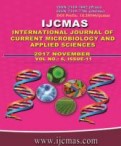


 National Academy of Agricultural Sciences (NAAS)
National Academy of Agricultural Sciences (NAAS)

|
PRINT ISSN : 2319-7692
Online ISSN : 2319-7706 Issues : 12 per year Publisher : Excellent Publishers Email : editorijcmas@gmail.com / submit@ijcmas.com Editor-in-chief: Dr.M.Prakash Index Copernicus ICV 2018: 95.39 NAAS RATING 2020: 5.38 |
An investigation was undertaken to detect the genetic architecture of resistance of maize Turcicum leaf blight using six generation mean analysis in the two crosses viz., B-104 × CML-124 (C-I) and CML-124 × B-104 (C-II) at College of Agriculture, V. C. Farm, Mandya during Kharif 2014-15. The estimates of scaling tests A and D were significant in B104 × CML124, C and D in CML124 × B104 which suggested the significance of both additive and dominant gene effect in the inheritance of resistance in both the crosses. The scaling tests as well as joint scaling tests reveals the inadequacy of simple additive-dominance model which justified the use of six parameter model for the detection of gene interactions. The components of means, additive and dominance were significant in cross B104 × CML124. The magnitude of dominance [h] effect was more compared to additive gene effect. Among interaction components, additive × additive [i] and additive × dominance [j] interaction effects were significant in positive direction, whereas dominance × dominance [l] interaction was significant in negative direction. In the cross CML124 x B104, the mean, additive and dominant [h] gene effects were significant but dominant genetic effect was significant in the negative direction. Among interaction components [i] was significant in negative direction, which implies that biparental mating or recurrent selection programmes can be used to bring out desirable genetic improvement.
 |
 |
 |
 |
 |